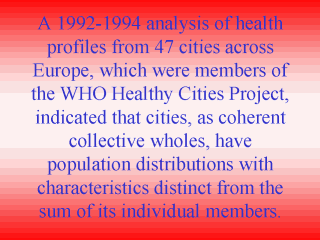 |
The
international and community-wide implications of the health gap between cities has been
systematically investigated by the WHO Healthy Cities Project, which addressed the problem
of reducing inequity as well as inequality. City health profiles act as a series of
monitoring reports, which describe health needs and health gaps, providing the rationale
for city health plans. The development of a city health profile is instrumental as an
initial policy step to reduce health gaps. Prevention and degree of personal choice are
used to distinguish between group health differences due to inequalities and inequities.
As discussed in a previous section, health inequalities are unavoidable or based largely
on personal choice, associated with individual risk factors; health inequities are due to
preventable unjust conditions, largely not under direct personal control, and associated
with social causes, such as the relative distribution of access to resources rather than
average level of access. |
